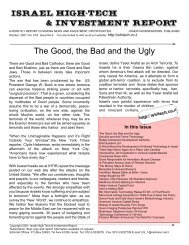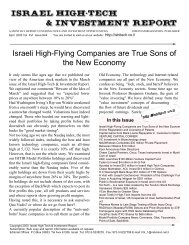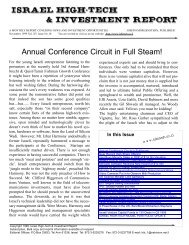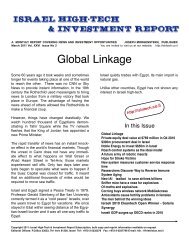Water, Water Everywhere... - The Israel High Tech & Investment Report
Water, Water Everywhere... - The Israel High Tech & Investment Report
Water, Water Everywhere... - The Israel High Tech & Investment Report
Create successful ePaper yourself
Turn your PDF publications into a flip-book with our unique Google optimized e-Paper software.
July-August<br />
ernment wants to increase to $10 billion<br />
over the next five years.<br />
Proving that necessity really is the mother<br />
of invention, we wandered between<br />
rows of jojoba trees on a patch of land<br />
south west of the Negev desert. About<br />
95 per cent of <strong>Israel</strong> is classed as arid<br />
or semi-arid, but companies such as<br />
Netafim are clawing back the land and<br />
making it fit for agriculture. Its drip irrigation<br />
techniques increase crop yields by<br />
50 per cent while using 40 per cent less<br />
water than alternative methods.<br />
Igal Aisenberg, chief executive of Netafim,<br />
pointed to a hole in the earth and a small<br />
underground pipe that runs the length of<br />
the field. This is the company’s product<br />
at work. Intermittently spaced drippers<br />
release water into the ground beneath<br />
the trees, a patented piece of technology<br />
that made the company a global<br />
success story and drip irrigation viable.<br />
While it remains more expensive than<br />
sprinklers and flood irrigation, drip technology<br />
is a lot more efficient, releasing<br />
water with pinpoint accuracy, an important<br />
consideration with such a scarce<br />
commodity. “It’s not just a hole in a pipe,”<br />
says Aisenberg. “It is pressure compensated<br />
so every dripper gives out exactly<br />
the same amount of water regardless of<br />
location.”<br />
Just south of Tel Aviv we see the source<br />
of the water and more cutting-edge technology.<br />
Vast man-made basins dominate<br />
the landscape, part of an industrial<br />
recharge-recovery system that reclaims<br />
waste water for use in irrigation. Run by<br />
Mekorot, <strong>Israel</strong>’s national water company,<br />
the Shafdan plant is the most<br />
advanced in the Middle East – 75 per<br />
cent of household wastewater is recycled<br />
in <strong>Israel</strong> and reused for irrigation.<br />
According to Amiad, another <strong>Israel</strong>i firm<br />
and one of the world’s leading waterfiltration<br />
companies, the only obstacle<br />
to drinking recycled wastewater is psychological.<br />
Filtration techniques have<br />
become so sophisticated that quality is<br />
not an issue.<br />
People are already drinking seawater.<br />
On the Mediterranean coast, <strong>Israel</strong> has<br />
the two largest reverse osmosis desalination<br />
plants in the world, run by a joint<br />
venture between indigenous firm IDE<br />
<strong>Tech</strong>nologies and French company Veolia<br />
<strong>Water</strong>.<br />
Pressurized seawater is pumped through<br />
thousands of polymer membranes that<br />
extract the brine and discharge it back to<br />
the ocean. Two cubic meters of seawater<br />
make one cubic meter of drinking water<br />
in industrial facilities that already supply<br />
50 per cent of the country’s household<br />
water, a figure that will increase to 70<br />
per cent with the completion of a third<br />
plant.<br />
Part of <strong>Israel</strong>’s agenda is to export its<br />
expertise and even wet countries such<br />
as Ireland are in its cross hairs. “You<br />
had a drought last winter because you<br />
couldn’t find the leaks in your infrastructure,”<br />
says Benjamin Levy, director of<br />
marketing at Miltel, a company that specializes<br />
in automatic metering and water<br />
management systems.<br />
He said 17,000 liters of water can be lost<br />
in month through a 3mm leak. Again,<br />
<strong>Israel</strong> is leading the world in tackling<br />
the problem. Only 12 per cent of water<br />
leaks out in the country’s infrastructure<br />
compared to 25 per cent in Europe, and<br />
35 per cent to 40 per cent in underdeveloped<br />
countries.<br />
6












